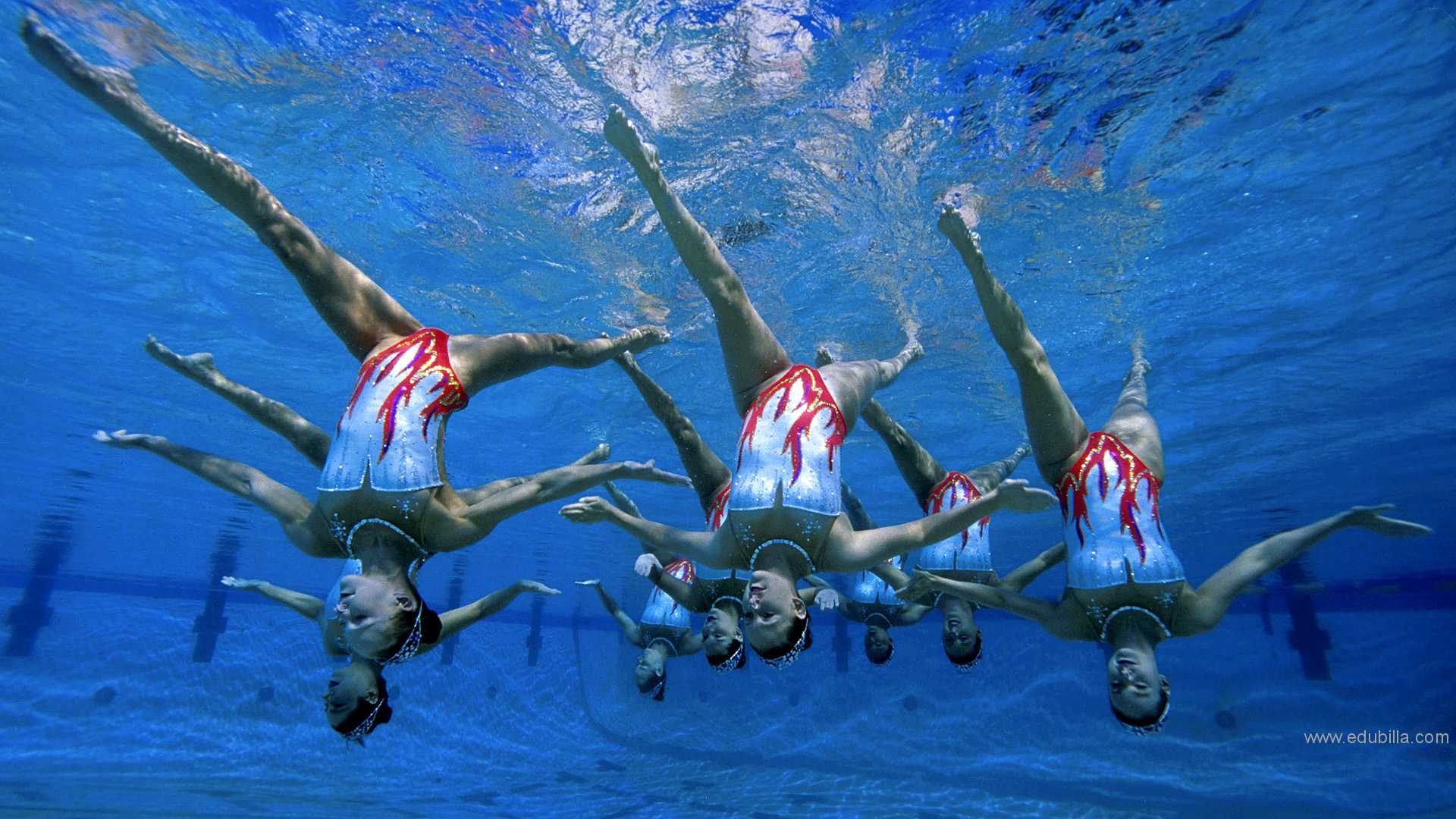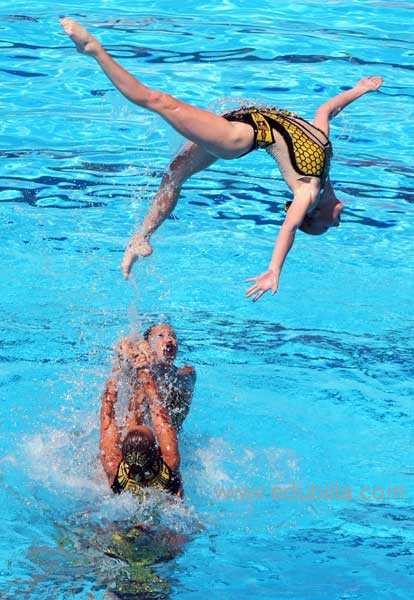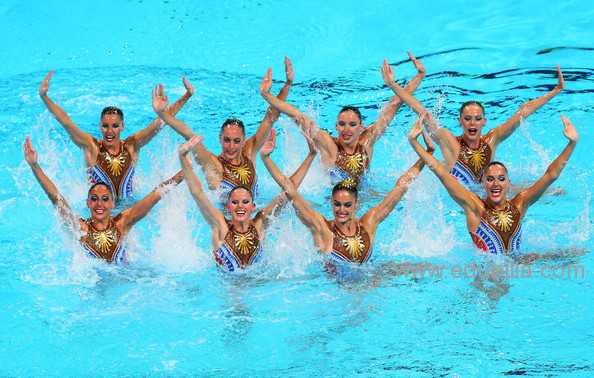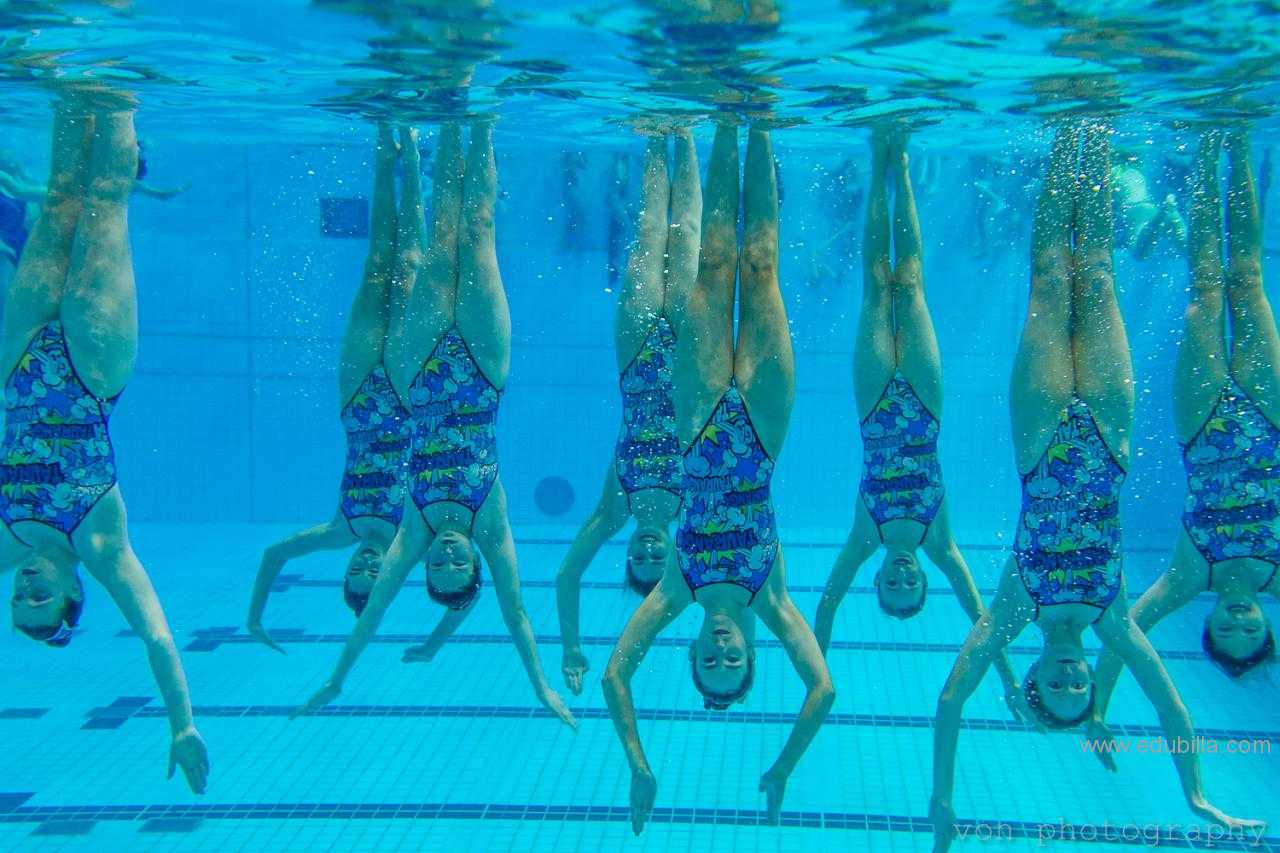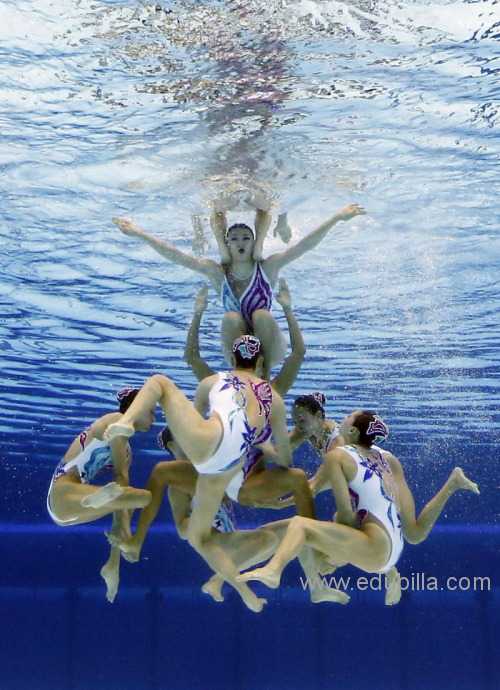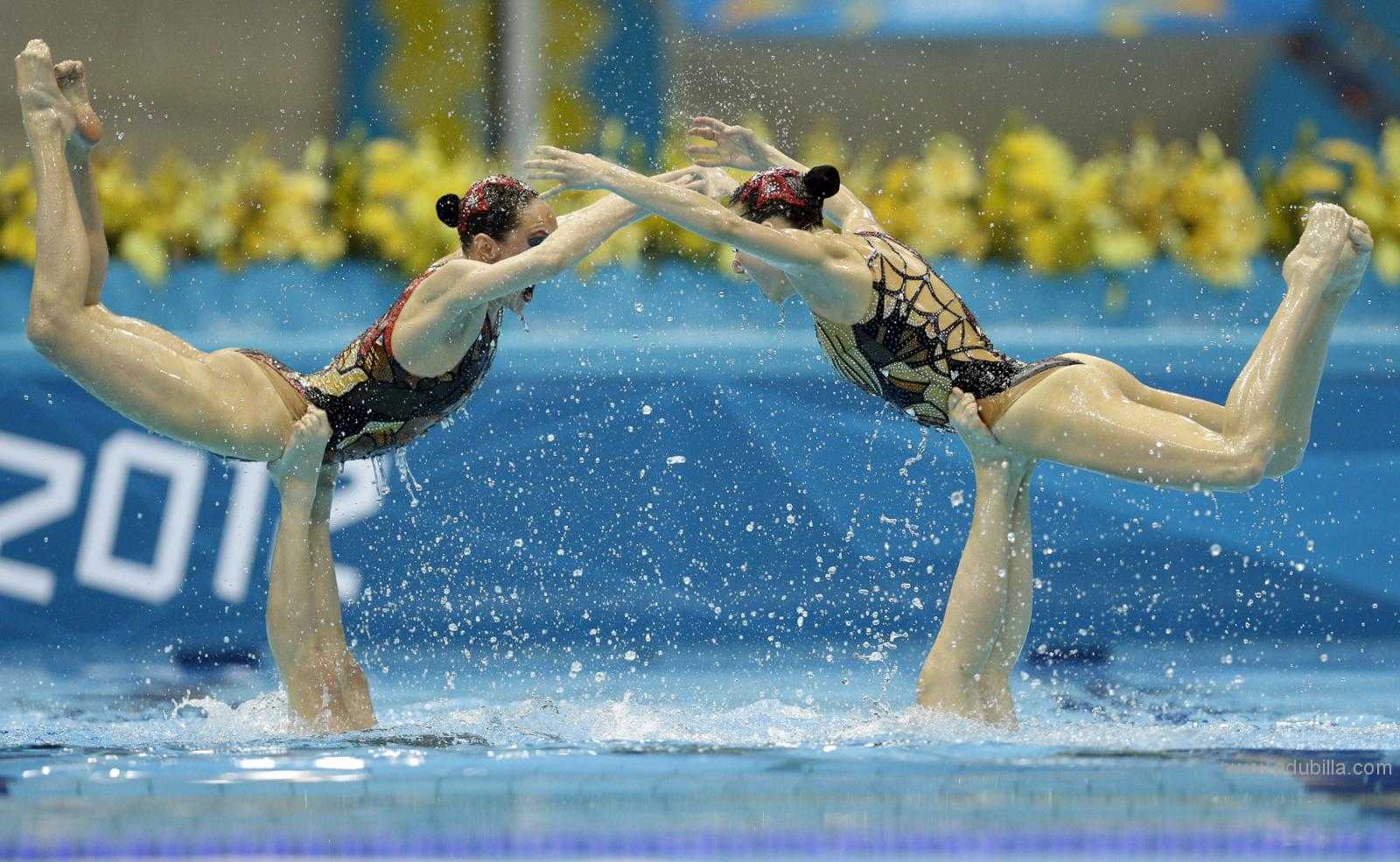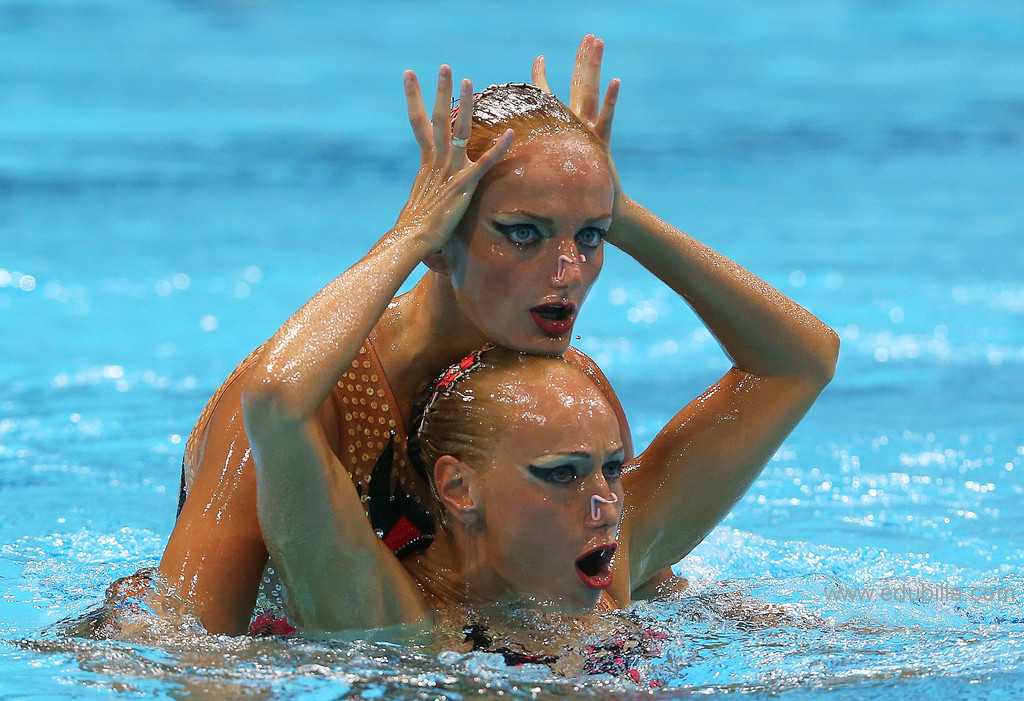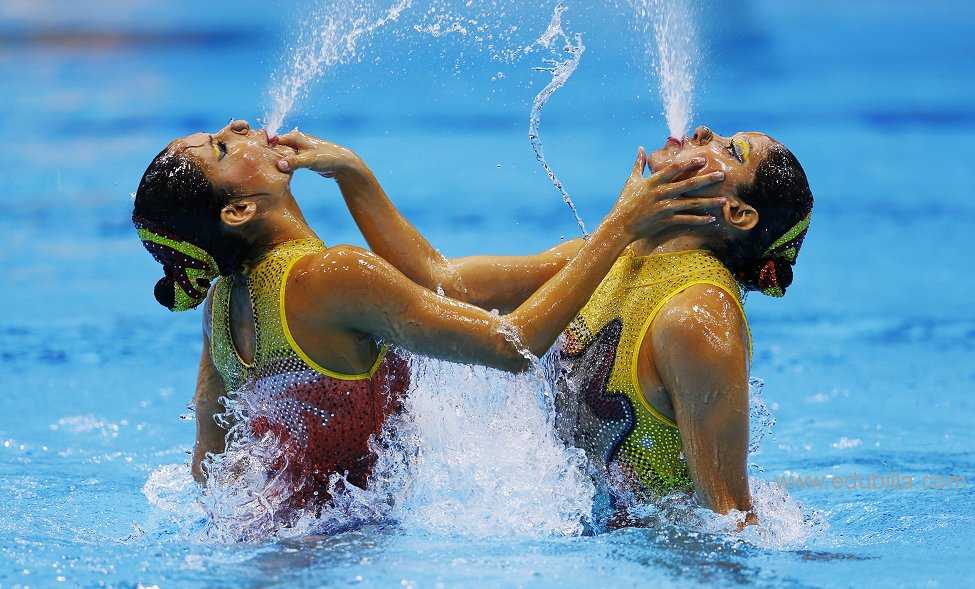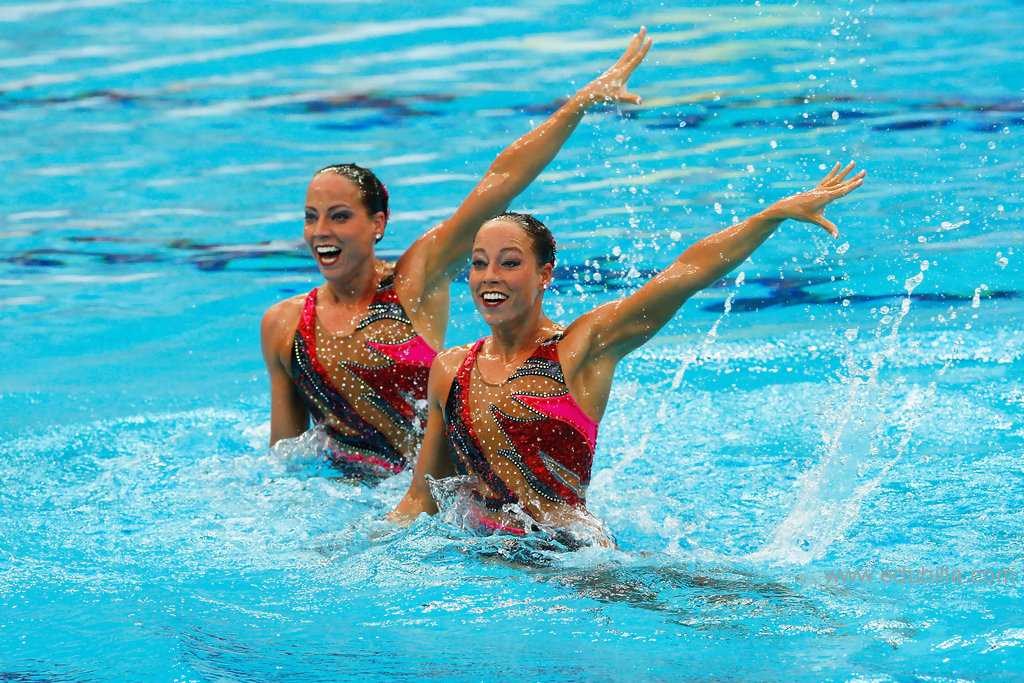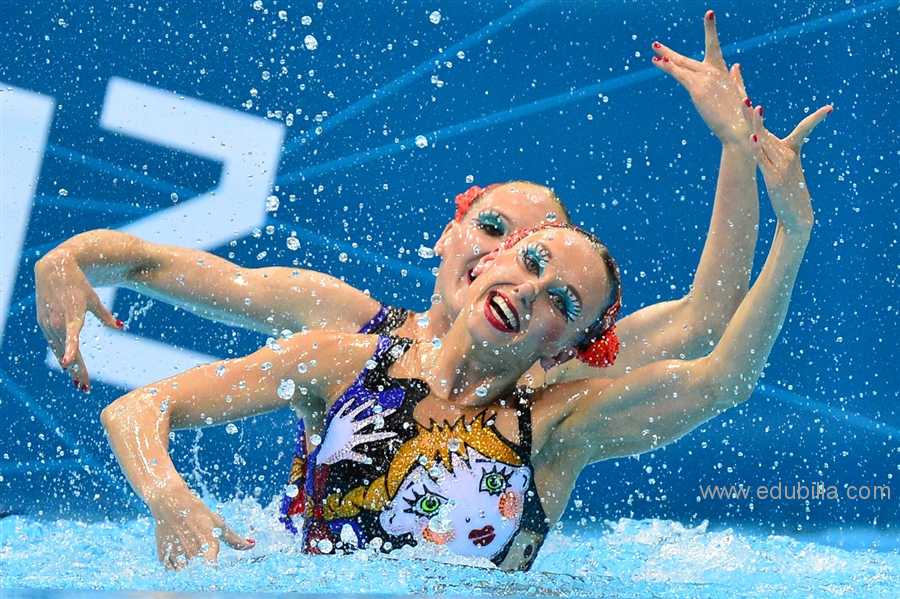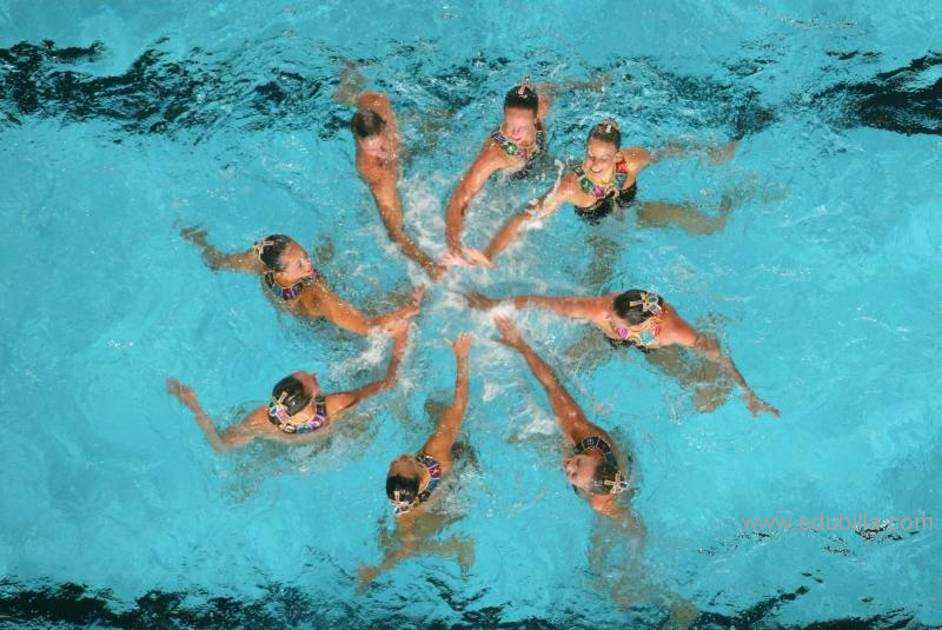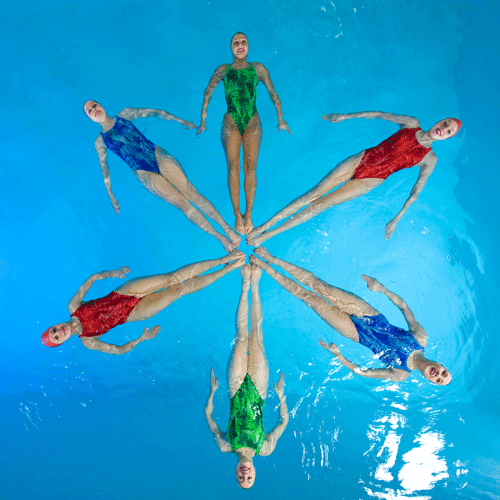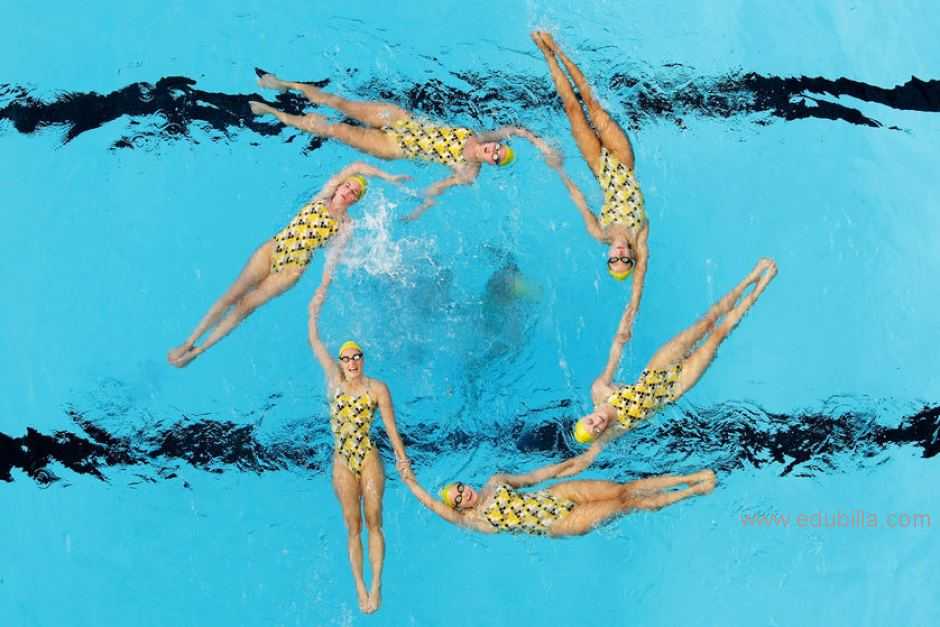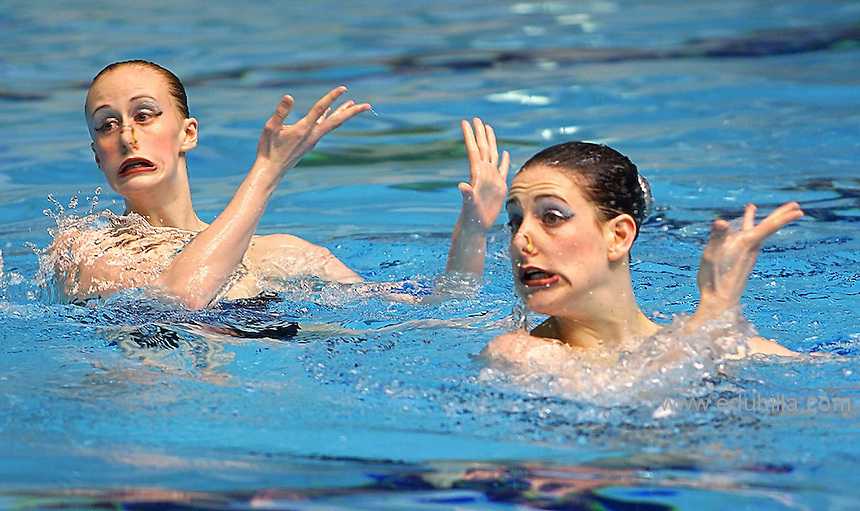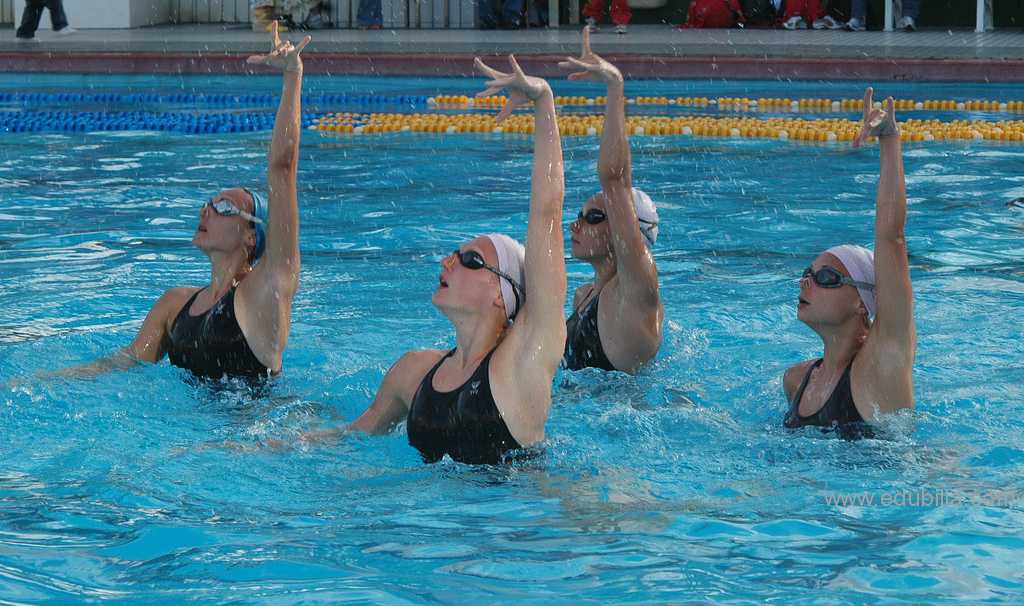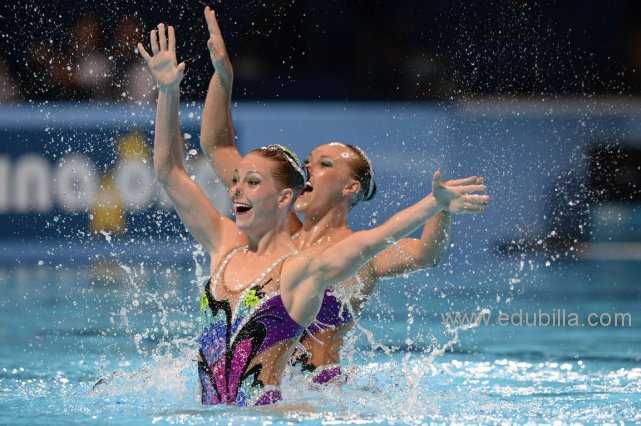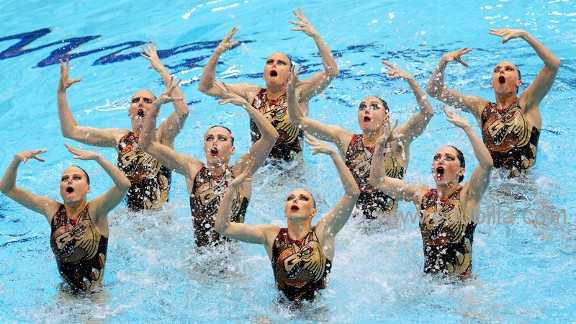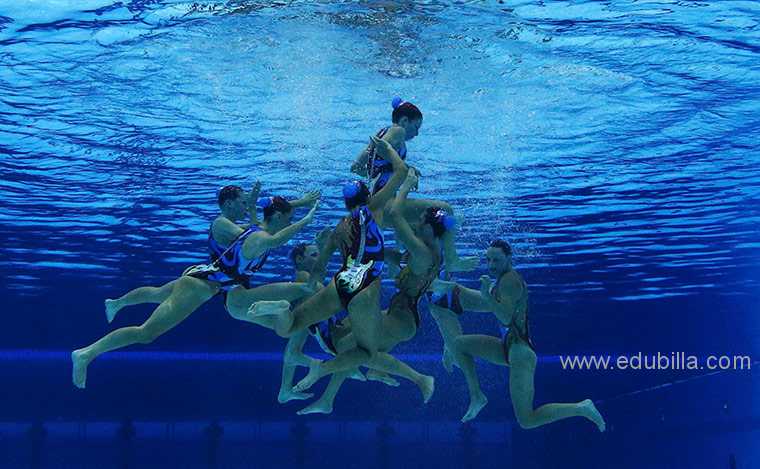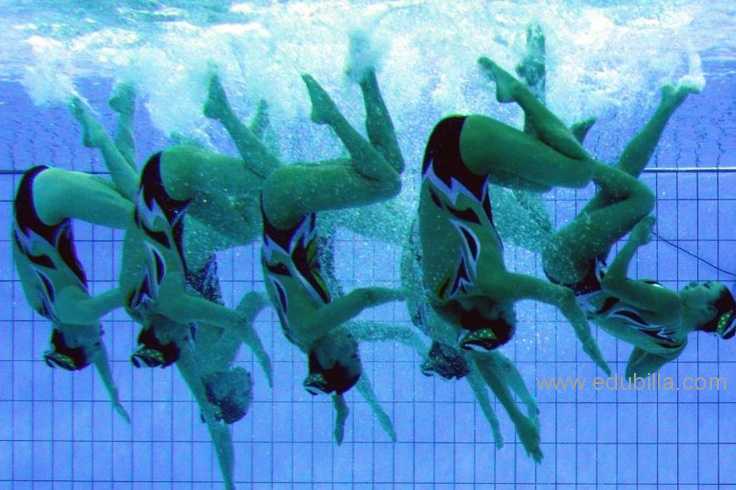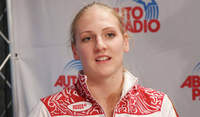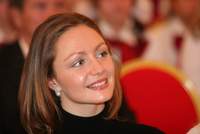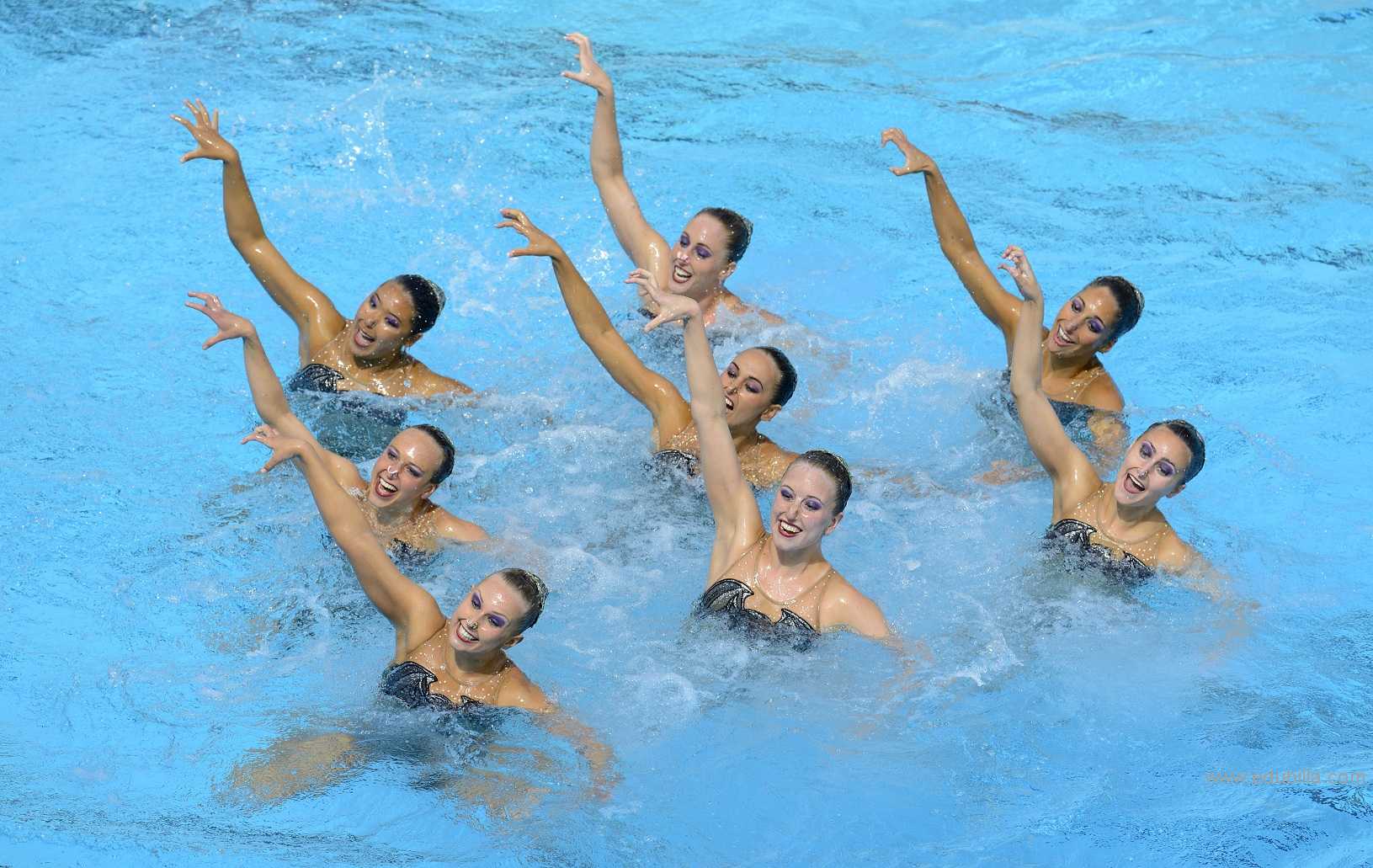
Overview Of Synchronized swimming
Synchronized swimming is a hybrid form of swimming, dance and gymnastics, consisting of swimmers (either solos, duets, trios, combos, or teams) performing a synchronized routine of elaborate moves in the water, accompanied by music. Although solos are not used in the Olympics, athletes can perform solos and compete in most other competitions. A recent addition to the Olympic repertoire is the event of mixed pairs, allowing men to compete with a female duet partner.
World Championship:
Aside from the new mixed-pair event, Olympic and World Championship competition is not open to men, but other international and national competitions allow male competitors in every event. Both USA Synchro and Synchro Canada allow men to compete with women. – Most European countries allow men to compete also, France even allows male only podiums, according to the number of participants. In the past decade more men are becoming involved in the sport and a global biannual competition called Men's Cup has been steadily growing.
Competition events in Synchronised Swimming:
There are four main categories of competition:
- Solos (where an individual swimmer will synchronise with the music).
- Duets (where a swimmer co-ordinates with their partner and in time to the music).
- Teams (where the swimmer co-ordinates with up to seven other athletes and in time to the music).
- Combo (a team routine where up to ten swimmers perform in one continuous routine but during the routine there will be segments where different numbers of swimmers will perform.
- Teams normally contain eight swimmers, but the minimum number for a team is four. Teams lose marks for every swimmer they have under the full complement because it is easier to synchronise the less people there are in a routine!
Positions and movements:
Synchronised swimming is based on a number of basic positions and transitions.. These include the obvious ones, such as performing a figure on the front or back or from a vertical position, to the more technical ones such as the flamingo position, where one leg is straight and the other is bent in the same kind of shape as a flamingo, hence the name!
certain movements:
There are also certain movements that swimmers can perform in many different ways, so for example a swimmer can spin in the water but this can be spinning 180degrees or moving their entire body for one rotation (360 degrees).
Music:
Music is integral to Synchronised Swimming. In the solo event it is all the swimmer has to synchronise with and swimmers in the duet and team routines must sychronise to each other and the music.
Costumes and make-up:
Synchronised swimmers will often have elaborate costumes. These costumes are used to highlight or emphasise the theme of the music. Costumes are not judged and so should not affect the scores.
Game Rules
Synchronized Swimming is governed internationally by FINA (Federation Internationale de Natation). They also govern water polo, diving, swimming, and masters swimming.
The Competition:
Swimmers and teams must qualify for the Olympic competition at other, earlier competitions. Once at the Olympic games, there are two events contested in synchronized swimming, team and duet.Within each of those events are two routines, a technical and a free routine. The same swimmers might perform in both team and duet events.
Team Event:
- eight swimmers on a team
- one alternate swimmer
Technical Routine
- 2:50 time limit ( + or -15 seconds)
- Perform a set routine of specific moves in a specific order
Free Routine
- 4:00 time limit ( + or -15 seconds)
- Perform a self-choreographed routine with no specific requirements
Duet Event:
- two swimmers
- one alternate swimmer
Technical Routine
- 2:20 time limit ( + or -15 seconds)
- Perfom a set routine of specific moves in a specific order
Free Routine
- 3:30 time limit ( + or -15 seconds)
- Perform a self-choreographed routine with no specific requirements
Judging:
Judging is based on technical merit and artistic impression and is assessed by two panels of five judges. Technical merit includes how the routine is executed, synchronisation and an overall impression. Artistic impression includes how the moves are choreographed and the choice of music.
Scoring:
Each panel accounts for half of the individual, duet or team’s mark. Both panels tally their results to form the final score.
Time limits:
Competitors have:
- 30 seconds to walk to the deck.
- 2 minutes to perform the individual technical routine.
- 2 minutes and 20 seconds to perform the duet technical routine.
- 3 minutes to perform the individual free routine.
- 3 minutes and 30 seconds to perform duet free routine.
Detailed Synchronized swimming Rules Can Be Downloaded From Documents
Equipments Need For Synchronized swimming
Swimsuit:
Swim suits shall be suitable for a sports event and shall be non-transparent.
Pool:
The pool must be a minimum of 20m by 30m, and within that a 12m by 12m area must be at least 3m deep. The water temperature must be 26 degrees Celsius, plus or minus one degree.
Underwater speakers:
Used to project music underwater.
Goggles:
Goggles and additional clothing is not permitted.
Nose clip:
A small clip of hard plastic or wire with a thin rubber coating, used to stop water from entering the nose during underwater movements.
History Of Synchronized swimming
Synchronised swimming is a relatively new discipline that has its origins in water acrobatics. It is hugely popular in the United States.
Glass tank performer:
At the turn of the 20th century, Annette Kellerman, an Australian swimmer, toured the United States performing water acrobatics. Her shows proved very popular and a sport was born.
Performing with music:
The sport was developed further by Katherine Curtis, who had the idea of combining water acrobatics with music. Her students performed at the 1933-34 Chicago "Century of Progress" Fair, where the announcer, former Olympic swimming gold medallist Norman Ross, coined the term "synchronised swimming".
Hollywood glamour:
Synchronised swimming was later popularised by American film star Esther Williams, who performed water ballet in several American movies. The competitive aspect was developed around the same time when Frank Havlicek, a student of Katherine Curtis, drew up a set of rules.
First Water Ballet Competition:
The first water ballet competition on record was held in Berlin, Germany in 1891, before the sport was actually called “synchronized swimming.” It’s rumored that clubs designed to participate in and host these competitions began to pop-up simultaneously in Australia, the USA, Canada, and France.
First U.S. Synchronized Swimming Competition:
On May 27, 1939, the first U.S. synchronized swimming competition took place at Wright Junior College between Wright and the Chicago Teachers' College.In 1924, the first competition in North America was in Montreal, with Peg Seller as the first champion.
Olympic history:
A relatively recent discipline, synchronised swimming became an Olympic sport for the first time in Los Angeles in 1984, with solo and duet events. These events also took place at the Olympic Games in 1988 in Seoul and in 1992 in Barcelona. Atlanta replaced them in 1996 by a water ballet for eight people. Since the 2000 Olympic Games, the Olympic programme has included the team event and the duet.
Alongside rhythmic gymnastics, synchronised swimming is the only exclusively female Olympic sport.
Origin Of Synchronized swimming
First choreography:
In 1863 Jacques Le PoPu was the first to choregraph several swimmers as Sync du Swim.
Katherine Whitney Curtis:
In 1933 & 1934, Katherine Whitney Curtis organized a show, "The Kay Curtis Modern Mermaids," for the World Exhibition in Chicago. The announcer was Norman Ross, who introduced the sport as "Synchronized Swimming" for the first time.
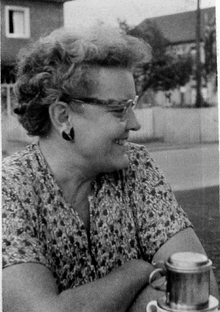
Amateur Athletic Union:
Curtis made Synchronized Swimming an officially recognized sport by the AAU in December 1941, but would herself be transferred overseas in 1943. She was the Recreation Director of the Red Cross under Generals Patton & Eisenhower, during which time she produced the first international aquacade in Caserta, Italy. She was the Director of Travel in post-war Europe until 1962. She was officially recognized along with Annette Kellerman by the Helms Hall of Fame in 1959 - Curtis as with the primary development of Synchronized Swimming.
International Swimming Hall of Fame:
In 1979, the International Swimming Hall of Fame inducted Curtis with similar accolades.
popularity:
In 1907, Australian Annette Kellerman popularized the sport when she performed in a glass tank as an underwater ballerina (the first water ballet in a glass tank) in the New York Hippodrome. After experimenting with various diving actions and stunts in the water, Katherine Curtis started one of the first water ballet clubs at the University of Chicago, where the team began executing strokes, "tricks," and floating formations.
A National A.A.U. champion swimmer, Esther Williams, would also largely popularize synchronized swimming during WWII and after, through (often elaborately staged) scenes in Hollywood films such as Bathing Beauty (1944), Million Dollar Mermaid (1952), and Jupiter's Darling (1955). In the 1970s and 80s, Ft. Lauderdale swimming champion Charkie Phillips revived water ballet on television with The Krofftettes in The Brady Bunch Hour (1976–77), NBC's The Big Show (1980), and then on screen with Miss Piggy in The Great Muppet Caper (1981)
First competition:
At the turn of the 20th century, synchronized swimming was known as water ballet. The first recorded competition was in 1891 in Berlin, Germany. Many swim clubs were formed around that time, and the sport simultaneously developed in Canada.
Governing Bodies
International Swimming Federation(FINA):
International Swimming Federation(FINA) is the International Federation (IF) recognized by the International Olympic Committee (IOC) for administering international competition in Aquatics. It is one of several IFs which administer a given sport/discipline for the IOC and/or international community. It is based in Lausanne, Switzerland.
FINA currently oversees competition in five aquatics sports: swimming, diving, synchronized swimming, water polo and open water swimming. Beginning in 2013, high diving is an emerging discipline within FINA. FINA also oversees "Masters" competition (for adults) in its disciplines.
On July 24, 2009, Julio Maglione of Uruguay was elected FINA President.

History:
FINA was founded on July 19, 1908 in the Manchester Hotel in London, UK at the end of the 1908 Summer Olympics by the Belgian, British, Danish, Finnish, French, German, Hungarian and Swedish Swimming Federations.
Number of national federations by year:
-1908: 8
-1928: 38
-1958: 75
-1978: 106
-1988: 109
-2000: 174
-2008: 197
-2010: 202
-2012: 203
Organization:
The FINA membership meets every four years, usually coinciding with the World Championships. There are two types of normal or "ordinary" congress: General and Technical. FINA’s highest authority is the General Congress. Any technical issues concerning FINA’s five aquatic disciplines are decided by the Technical Congress. Each Congress has two voting members from each Member federation, plus the following non-voting members: the 22 members of the Bureau, the Honorary Life President, and all Honorary Members. The Technical Congress has the following additional non-voting members: all members from the respective Technical Committees. "Extraordinary" Congress are also called from time to time, to deal with a specific topic or area of concern (e.g., an Extraordinary Congress was held with the 2009 World Championships to review the Masters swimming rules; there was a General Congress at the 2009 Worlds). All Congress meetings are chaired by FINA's president.
Events:
FINA organizes one championship involving each of the five disciplines it oversees (the "World Championships"), as well championships and circuits in each of the disciplines.
World Championships:
The biggest FINA event is the biennial World Championships, currently held every odd year. It features competitions in all five aquatic disciplines. Prior to 2000, the event was held every 4 years, in the even year between (Summer) Olympic Games.
Discipline championships:
-Swimming: World Swimming Championships (25m), (aka "Short Course Worlds"). Bi-annual event (in even years), swum in 25-meter length pool (Olympic and World Championships are in a 50m pool).
-Water Polo: Water Polo World Leagues (men's and women's).
-Diving: Diving World Series
-Open Water: World Open Water Swimming Championships (aka "Open Water Worlds"). Even years from 2000-2010.
-Synchronized Swimming: Synchro World Cup.
-Masters:World Masters Championships (aka "Masters Worlds"). Bi-annual, in even years. "Masters" competition is for adults (20 years old and up). This championships features all 5 disciplines.
Other events:
In addition to the championships events listed above, FINA also organizes the following annual events, and sub-championships:
World Cups: in swimming, water polo (men's, women's), diving, high diving, open water (10Ks) and synchro.
Grand Prix: Annual race/competition series of multiple events in open water (races over 10-kilometers).
Junior Worlds: A world-level championships restricted to a younger age population (typically under-18, though can vary by discipline/gender). Held in swimming, water polo, diving, and synchronized swimming. Open Water is to begin in 2012.
To Visit FINA Click Here
Awards Related To Synchronized swimming
Synchro Canada Awards:
The Synchro Canada Volunteer Awards represent your opportunity to nominate individuals within your province who have made a significant contribution to our sport.
» Life Time Achievement Award
» Sylvie Fortier Award
» Bridge Builder Award
» Board of Directors Honour Award
» President\'s Award
» Silver Pin Award
Synchro Swim Ontario Provincial Awards:
Each year, Synchro Swim Ontario presents a Volunteer of the Year, Coach of the Year and Athletes of the Year Awards. These awards are presented at the Athlete Banquet at the Ontario Open Age Group Synchronized Swimming Championships.
Guelph Synchronized Swim Club
Synchro Swim Ontario Trillium Awards:
The Trillium Awards Program was developed to serve the interests of participants across the province of Ontario. It is a ten (10) level graduated skill development program aligned with the Canadian Sport for Life (CS4L)
Sample Documents Of Synchronized swimming
-Andre Agassi

